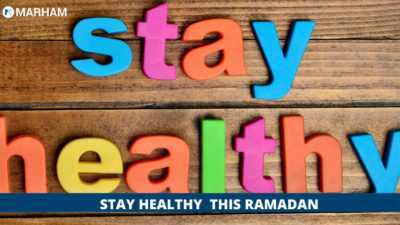Ramadan is the ninth month of the Islamic calendar and a time when many Muslims worldwide fast during daylight hours for 29-30 days. As Ramadan is approaching, many of us are wondering how to stay full this Ramadan. The Islamic calendar is lunar, Ramadan occurs at a slightly earlier time each year. During Ramadan, Muslims do not eat or drink anything during the day, instead eating one meal (the’suhoor’ or’sehri’) just before dawn and another (the ‘iftar’) after sunset. ‘Eid-ul-Fitr,’ or the Festival of the Breaking of the Fast, marks the end of Ramadan. While fasting is mandatory for everyone, here we will see that how to stay full this Ramadan.


Is Fasting Good for Health?
The findings of studies on the health effects of Ramadan fasting are mixed, owing to the fact that the length of the fast and the weather conditions experienced vary depending on the time of year and the country where the fast is observed. According to some studies, people who are overweight or obese lose weight and body fat during Ramadan (although they tended to put this weight back on after Ramadan). If you are overweight and want to lose weight and keep it off, making plans to maintain a healthy diet and get active after Ramadan ends may help you maintain any weight lost due to fasting.
What to Eat and Drink at Iftar and Suhoor?
Following are some tips for what to eat at Suhoor and Iftar:
Suhoor
Drink plenty of fluids, choose fluid-rich foods to stay hydrated for the day ahead, and go for starchy foods for energy, opting for high fibre or wholegrain varieties where possible as these can help keep you feeling fuller and aid digestion, preventing constipation. Here are a few examples:
- Oats are wholegrains, and you can make porridge, which also contains fluids because it is made with milk or water, muesli with milk or yogurt, or overnight oats. Toppings could include fresh or dried fruit, nuts, or seeds.
- High fibre breakfast cereals – these contain a lot of fibre and are frequently fortified with vitamins and minerals, which add extra nutrients. You also get them because they are consumed with milk.
- Starchy foods such as rice or couscous – try rice pudding with fruit or couscous or other grains with dairy or fruit. If you choose savoury dishes for suhoor, make sure they are not too salty, or they will make you thirsty during the fast.


- Yogurt – This is a good food to include at suhoor because it contains fluid and contains nutrients such as protein, calcium, iodine, and B vitamins. As in the previous examples, you could pair it with cereal and fruit. * Breads – choose wholegrain options for more fibre, such as wholemeal toast or chapattis. Bread should not be combined with salty foods such as hard cheese or preserved meats. You could experiment with nuts.
- Because bread is fairly dry, drink plenty of water or other fluids with it, or have fluid-rich foods like lentil soup, which is a traditional suhoor food in some countries. Consult with a nutritionist right now.
Iftar
When first breaking the fast, drink plenty of fluids and eat low-fat, fluid-rich foods with some natural sugars for energy (avoid consuming a lot of foods or drinks with added sugars). Here are a few examples:
- Drinks – water, milk, fruit juices, or smoothies – water hydrates without adding calories or sugars.
- Drinks based on milk and fruit provide some natural sugars and nutrients – these are also good for breaking the fast; however, avoid drinking a lot of drinks with added sugars after breaking the fast as these can provide too many sugars and calories.
- Dates – traditionally eaten to break the fast since the Prophet Muhammad’s time, dates are a great way to break the fast because they provide natural sugars for energy, minerals like potassium, copper, and manganese, and are a source of fibre. You could also try dried fruits like apricots, figs, raisins, or prunes, which are high in fibre and nutrients.
- Fruit – a traditional way for South Asian cultures to break the fast, fruit provides natural sugars for energy, fluid, and some vitamins and minerals. To know more discuss with a nutritionist.


- Soup is a light way to break the fast and provides fluid in many Arab countries. Traditional soups are made with a meat broth and frequently include pulses like lentils and beans, as well as starchy foods like pasta or grains, which provide nutrients and energy. After breaking the fast – meals vary according to culture and tradition, but try to eat a variety of starchy foods, including wholegrains where possible, fruit and vegetables, dairy foods, and protein-rich foods such as meat, fish, eggs, and beans, as recommended by the Eatwell Guide.
- For example, you could serve a variety of curries with fish, meat, vegetables, and pulses, along with rice, chapattis, and yoghurt, and this would cover all of the Eatwell Guide’s key food groups. More information on the Eatwell Guide can be found on the NHS website.
Consult the Best Nutritionists in Pakistan
Book an appointment now, to answer all your queries. You can book an appointment with the top nutritionists in Pakistan through Marham by calling at Marham helpline: 0311-1222398 or by online booking facility through the website or Marham mobile app.
Can’t Find The App
| Android | IOS |
|---|---|
  |
  |
FAQ’s
1. How can I stay full during Ramadan fast?
Suhoor – drink plenty of fluids, choose fluid-rich foods to stay hydrated for the day ahead, and go for starchy foods for energy, opting for high fibre or wholegrain varieties where possible as these can help keep you feeling fuller and aid digestion, preventing constipation.
2. How can I stop being hungry in Ramadan?
- Never skip a pre-dawn meal.
- Take a short nap to recharge your batteries.
- Stay hydrated and avoid direct sunlight.
- Avoid overeating at breakfast.
- Doing daily chores and avoiding rest throughout the day.
3. What should I eat for iftar?
Iftar is a time to replenish energy levels, so make every effort to consume foods from all major food groups: fruit and vegetables, rice and alternatives, and meat and alternatives (including dairy). The Health Promotion Board (HPB) suggests eating two servings of vegetables and two servings of fruit per day.

